The Witcher 3: Blood and Wine — Komplettlösung, Tipps und Tricks
The Witcher 3: Blood and Wine ist Geralt von Rivas vorerst letzter Videospielauftritt und ein fantastischer Abschluss dieses ohnehin verschwenderisch großen Spiels. Entwickler CD Projekt hat noch mal die Ärmel nach oben gekrempelt und in Form von Toussaint ein neues, vom Rest der Spielwelt abgetrenntes Gebiet aus dem Boden gestampft, das sich mit Velen und Novigrad locker messen kann. In Blood and Wine wartet eine lange neue Hauptquest auf euch, die Geralts Reise einen Schlusspunkt setzt, viele Nebenquests, Hexeraufträge, Schatzsuchen und so einiges mehr.
30 Stunden neue Inhalte kriegt man hier locker zusammen, sofern man nicht von einer Quest zur nächsten hetzt. In der Blood-and-Wine-Komplettlösung decken wir das ab und erkunden das farbenfrohe Märchenland Toussaint, so gut es geht. Seid ihr dagegen auf der Suche nach Hilfe zum Hautspiel oder zur ersten Erweiterung, empfiehlt sich ein Blick entweder in die Komplettlösung zu The Witcher 3 oder in die Komplettlösung zu Hearts of Stone.
Inhaltsverzeichnis: Komplettlösung Witcher 3: Blood & Wine
Witcher 3: Blood and Wine: Hauptquests
Für Geralt startet das Add-on wie so oft mit einem harmlos scheinenden Monstervertrag. Die Hintergründe entwickeln sich langsam zu Größerem und der Hexer gerät in Machenschaften, die niemand absehen konnte.
Witcher 3: Blood and Wine: Nebenquests
Abgesehen vom Plot um die Bestie von Toussaint gibt es beachtlich viele Nebengeschichten, denen zu folgen allein schon durch ihre hohe Qualität empfehlenswert ist.
Witcher 3: Blood and Wine: Hexeraufträge
So manches hartnäckige Monster hält Toussaint und Umgebung in Atem. Nur ein Hexer kann da noch helfen, besonders wenn eine dicke Belohnung herausspringt.
Witcher 3: Blood and Wine: Winzeraufträge
Neben den großen, spannend angelegten Hexeraufträgen gibt es diese kleinen, meist in wenigen Minuten abgeschlossenen Monsterjagden, in denen Geralt in Not geratenen Winzern unter die Arme greift.
Witcher 3: Blood and Wine: Schatzsuchen
In Misthaufen, Schiffswracks, Kellern und alten Ruinen kann Geralt wieder den raffgierigen Schatzjäger geben und verdient dabei alles andere als schlecht.
Witcher 3: Blood and Wine: Fundorte Großmeister-Hexerausrüstung
Es sind mit die besten Rüstungssets, die man in The Witcher 3 finden kann. Fünf Stück an der Zahl, jeweils bestehend aus sechs Schemata. Hier die Fundorte.
The Witcher 3 Cheats: Alle Codes und IDs für Geld, Waffen, Godmode und mehr
The Witcher 3 Cheats: Alle Codes und IDs
Natürlich ist Blood and Wine erkennbar eine Erweiterung zu The Witcher 3. Und da man für die neuen Quests ohnehin etwa Stufe 35 erreicht haben sollte, findet man sich inhaltlich als Witcher-Veteran schnell zurecht. Schnellreise, schwarze Bretter, Hexeraufträge, Schatzsuchen, Tränke, Schmieden, Quests annehmen und abgeben, all das funktioniert gewohnt. Dennoch vorab einige Punkte zu Toussaint.
Spielwelt
Das Areal von Toussaint ist komplett neu und nur begehbar, wenn man Blood and Wine installiert hat. Wie Skellige fungiert es als vom Rest abgetrenntes Gebiet und kann jederzeit über die Schnellreisepunkte angesteuert werden, wenn man einmal da war, sprich: die Quest «Gesandte und Männer des Weins» abgeschlossen hat. Ihr könnt wie gewohnt Plötze benutzen und die Umgebung nach Gusto erkunden. Aber wie gesagt: Unter Level 35 ist das keine so gut Idee. Viele Monster bewegen sich über Stufe 40 und reißen euch in wenigen Sekunden den Hexerhintern auf, wenn ihr unachtsam durch die farbenfrohe Märchenwelt torkelt.
Spielstart
Es gibt mehrere Arten, Blood and Wine zu starten. Seid ihr im Rahmen der Hauptquest weit genug (Rittersporn muss schon befreit und damit die Hauptquest «Ein Poet in Nöten» abgeschlossen sein) oder bereits durch, bekommt ihr automatisch eine Quest namens «Gesandte und Männer des Weins», die ihr an einem schwarzen Brett vorantreibt.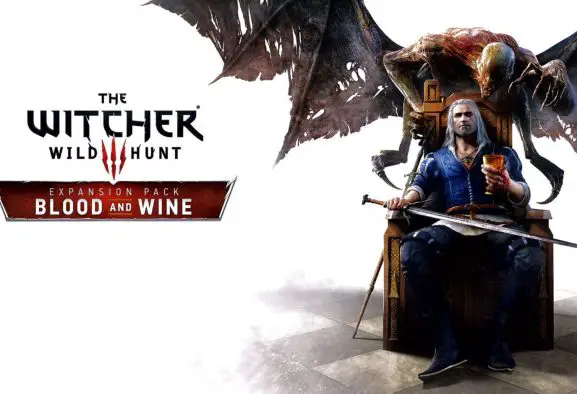 Folgt den Geschehnissen um die beiden Ritter Palmarin und Milton, dann kommt ihr nach Toussaint. Die Rückreise nach Velen, Skellige oder Novigrad ist über einen Schnellreisepunkt möglich.
Folgt den Geschehnissen um die beiden Ritter Palmarin und Milton, dann kommt ihr nach Toussaint. Die Rückreise nach Velen, Skellige oder Novigrad ist über einen Schnellreisepunkt möglich.
Verfügt ihr über keine Spielstand mehr, könnt ihr genauso gut im Startmenü von The Witcher 3 einen extra fürs Add-on angelegten Spielstand laden. Darin ist die Hauptquest automatisch abgeschlossen, Geralt startet auf Stufe 35, den nötigsten Tränken, Ölen und Absuden. Ihr seid damit einigermaßen gerüstet für die vor euch liegenden Geschehnisse, aber vergesst auf keinen Fall, vorher eure Charakterpunkte zu verteilen.
Weingut Corvo Bianco
Nach kurzer Zeit in der neuen Hauptstory kommt Geralt unerwartet in den Besitz eines Weinguts und die Quest «Zu Hause ist es am schönsten» startet. Das Abschließen derselben ist jedem wärmstens empfohlen. Zum einen habt ihr ein prächtiges Anwesen und Gelände mitten in einem der schönsten Landstriche der ganzen Reihe. Zum anderen werdet ihr mit den Aufbauarbeiten rund um das Weingut endlich die vielen Münzen los, die ein Hexer so mit sich herumschleppt. Ihr könnt hier zum Beispiel Rüstungsständer für nicht mehr benutzte Klamotten aufstellen oder ein Bett fertigen lassen, das euch beim Schlafen einen Perk verleiht, darunter Angriffsboni für einen bestimmten Zeitraum. Gönnt ihr Plötze einen Stall, erhaltet ihr einen Ausdauerbonus fürs Reiten. Setzt ihr die Schmiede instand, lassen sich dort entsprechende Arbeiten vornehmen und vieles mehr.
Ihr könnt hier zum Beispiel Rüstungsständer für nicht mehr benutzte Klamotten aufstellen oder ein Bett fertigen lassen, das euch beim Schlafen einen Perk verleiht, darunter Angriffsboni für einen bestimmten Zeitraum. Gönnt ihr Plötze einen Stall, erhaltet ihr einen Ausdauerbonus fürs Reiten. Setzt ihr die Schmiede instand, lassen sich dort entsprechende Arbeiten vornehmen und vieles mehr.
Winzeraufträge
Eine neue Art von Quests sind die sogenannten Winzeraufträge, die im Tagebuch unter Nebenquests landen, aber immer entsprechend gekennzeichnet sind. Beim Durchqueren der Spielwelt gerät Geralt immer wieder in Leute auf den Feldern, die Probleme mit Monstern haben. Das ähnelt ohne Frage den Hexeraufträgen, die man seit Wild Hunt kennt, aber sie sind deutlich weniger komplex. Meist geht es nur darum, «ja» zu sagen, in eine Höhle zu stiefeln und allem, was darin herumkraucht, das Fell über die Ohren zu ziehen. Sollte man trotzdem nicht einfach ignorieren, allein schon der Erfahrung und vergleichsweise leichten Beute wegen.
Erfahrung und Leveln
Derselbe Hinweis wie bei Hearts of Stone: Haut ruhig Gegner zu Klump, die mehrere Level unter euch sind. Im Gegensatz zum Hauptspiel werfen diese gern noch so manche überraschend hohe EXP-Menge ab, obwohl sie keine Herausforderung mehr darstellen. Beispiel: Ein Stufe-50-Geralt bekommmt fürs Besiegen einer Stufe-47-Bruxa nach wie vor über 20 EXP. Es lohnt sich also selbst dann, wenn man schon bärenstarke Schultern hat, die Welt zu erkunden und sich Gegner vorzunehmen, im Gegensatz zum Hauptspiel, wo man irgendwann nur noch einen lumpigen Punkt bekam. Ihr levelt in Blood and Wine ohnehin deutlich schneller, nicht nur wegen der Gegner.
Neue Monster
Im Gegensatz zu Hearts of Stone tummeln sich in Blood and Wine hauptsächlich neue Gegner. Klar, der eine oder andere Wolf hat es hierher geschafft. Die gibt es überall. Ansonsten jedoch könnt ihr euch freuen auf zwanzig neue Arten von Feinden, von Wichten bis hin zu Platzern, Vampiren bis Relikten.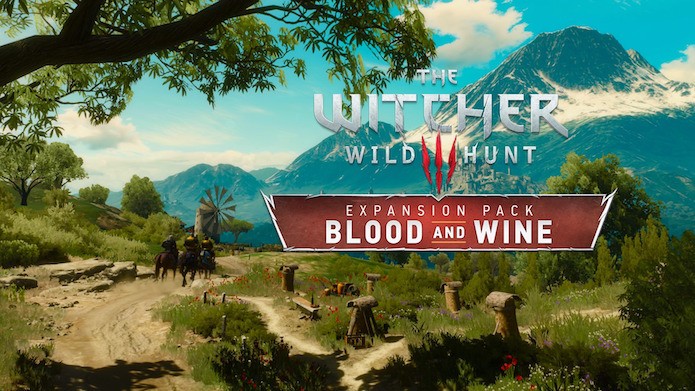 Und Bosse! CD Projekt war ganz verschossen in die Idee, das neue und letzte Kapitel der Hexerreise mit Bossen aufzuwerten. Entsprechend oft stoßt ihr auf die dickeren Kerle entlang des Weges, wo bloßes Draufhauen höchstens ins Hexerkrankenhaus führt.
Und Bosse! CD Projekt war ganz verschossen in die Idee, das neue und letzte Kapitel der Hexerreise mit Bossen aufzuwerten. Entsprechend oft stoßt ihr auf die dickeren Kerle entlang des Weges, wo bloßes Draufhauen höchstens ins Hexerkrankenhaus führt.
Blood & Wine | Komplettlösung | The Witcher 3
Blood & Wine | Komplettlösung | The Witcher 3 | RPGuides
Blood & Wine
Gesandte und Männer des Weins
Der Blood & Wine Abschnitt von Witcher 3 kann innerhalb der Haupthandlung des Spiels ab dem Abschluss der «Ein Poet in Nöten (Poet Under Pressure)» Quest begonnen werden. Als Charakterstufe ist 34 aufwärts jedoch zu empfehlen. Ideal wäre es, wenn die komplette Hauptgeschichte abgeschlossen ist. Zwar liefert Blood & Wine ebenso eine vorgefertigte Variante, falls ihr euren Spielstand verlegt habt. Aber die Blood & Wine Erweiterung repräsentiert gewissermaßen das endgültige Ende der Witcher Reihe und das Ende des Hauptspiels nimmt Einfluss auf das Blood & Wine Ende.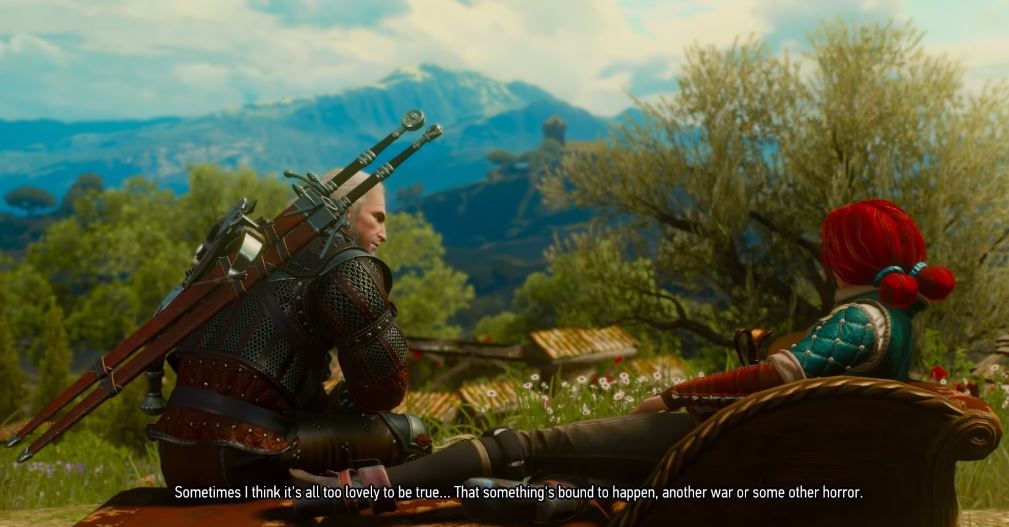 Mit der vorgefertigten Version, oder wenn ihr die Haupthandlung nicht abgeschlossen habt, fällt es somit geringfügig spärlicher aus. Glaubt ihr bereit für neue Abenteuer zu sein, so sucht ein beliebiges Anschlagbrett auf.
Mit der vorgefertigten Version, oder wenn ihr die Haupthandlung nicht abgeschlossen habt, fällt es somit geringfügig spärlicher aus. Glaubt ihr bereit für neue Abenteuer zu sein, so sucht ein beliebiges Anschlagbrett auf.
Der Aushang «Aufruf an Ritter Geralt von Riva mit der Brücke im Wappen» führt euch zur Siedlung der Steinschneider, westlich von Oxenfurt, in Velen. Palmerin de Launfal und Milton de Peyrac-Peyran argumentieren dort mit den Bürgern, die sie beschützen wollen. Das Duo will den Plünderern ein Ende bereiten, weil sie geschworen haben, gegen Ungerechtigkeit und Unterdrückung zu kämpfen. Ihr habt die Wahl zu kämpfen:
- Lasst mich euch bei den Banditen helfen.
Diese Option führt unweigerlich zum Kampf. Milton und Palmerin versuchen den Banditen mit Worten bei zu kommen und Geralt kann ihnen ebenfalls einen Weisen Rat geben, aber das ändert nichts. Ihr müsst die Banditen töten und zieht automatisch ab, bevor ihr die Leichen plündern dürft. - Wenn ihr diese Banditen besiegt, kommen die nächsten.

Geralt argumentiert, dass es keinen Sinn macht, die Banditen zu beseitigen. Wenn sie tot sind, kommen die nächsten. Also zieht das Trio ohne Kampf ab, wie es die Bauern gewünscht haben.
Palmerin verliest das Gesuch der Herzogin von Toussaint und selbstverständlich könnt ihr den Auftrag ablehnen. Aber dann startet das Blood & Wine Abenteuer nicht.
David und Golyat
Der Ritt ins Herzogtum Touassint beginnt mit einer skurrilen Szene. Ein Ritter scheint eine Windmühle anzugreifen. Wie sich Sekunden später zeigt, kämpft er jedoch gegen Golyat, welcher aus der Dulcinea-Windmühle hervorspringt und den Mühlenstein als Keule schwingt. Dieser Eröffnungskampf von Blood and Wine ist die Gelegenheit für den «David and Golyat» Erfolg, der sich nur in diesem Moment holen lässt und somit extrem leicht zu verpassen ist. Um die Trophäe zu bekommen, müsst ihr Golyat mit einem Armbrustbolzen töten.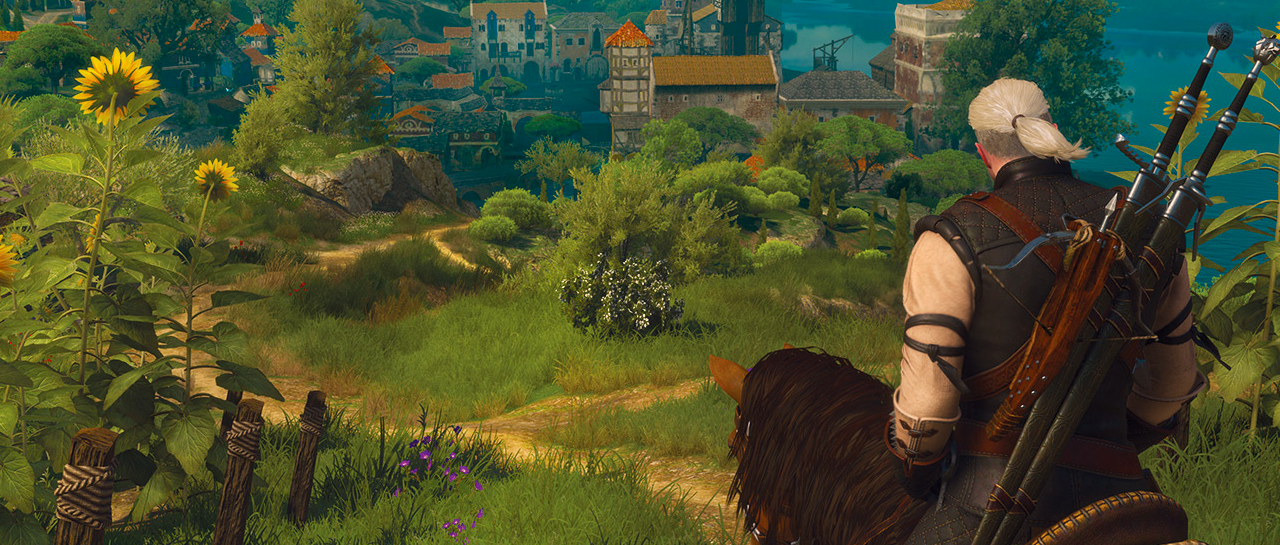 Zielt mit der Armbrust auf das Loch im Fass (vorne), was Golyat als Helm benutzt. Das ist bereits schwer genug überhaupt richtig zu zielen und um so schwerer, wenn euch der Hüne dabei angreift. Damit es etwas einfacher wird, ist die Lichtreflexe Fertigkeit zu empfehlen. Welche ihr leider schon zuvor in Velen festlegen müsst, da es hier im Kampf nicht mehr möglich ist.
Zielt mit der Armbrust auf das Loch im Fass (vorne), was Golyat als Helm benutzt. Das ist bereits schwer genug überhaupt richtig zu zielen und um so schwerer, wenn euch der Hüne dabei angreift. Damit es etwas einfacher wird, ist die Lichtreflexe Fertigkeit zu empfehlen. Welche ihr leider schon zuvor in Velen festlegen müsst, da es hier im Kampf nicht mehr möglich ist.
Interessiert euch der Erfolg nicht, ist die Schlacht deutlich einfacher. Golyat richtet zwar enormen Schaden an, aber seinen Angriffen ist leicht auszuweichen und wenn ihr den Quen-Schild aktiviert, fängt der eine Menge Schaden ab. Achtet stets auf Golyats Körperhaltung. Hebt er ein Bein, müsst ihr zur Seite wegrollen, um der trichterförmigen, frontalen Druckwelle zu entgehen. Reißt er hingegen den Arm mit dem Mühlenstein in die Höhe, wirbelt er als nächstes um 360°. In dem Fall müsst ihr von Golyat weg rollen.
Mit welcher Waffe ihr Golyat auch besiegt habt, muss sich Guillaume eingestehen, dass Geralt und nicht er den Kampf gewonnen hat.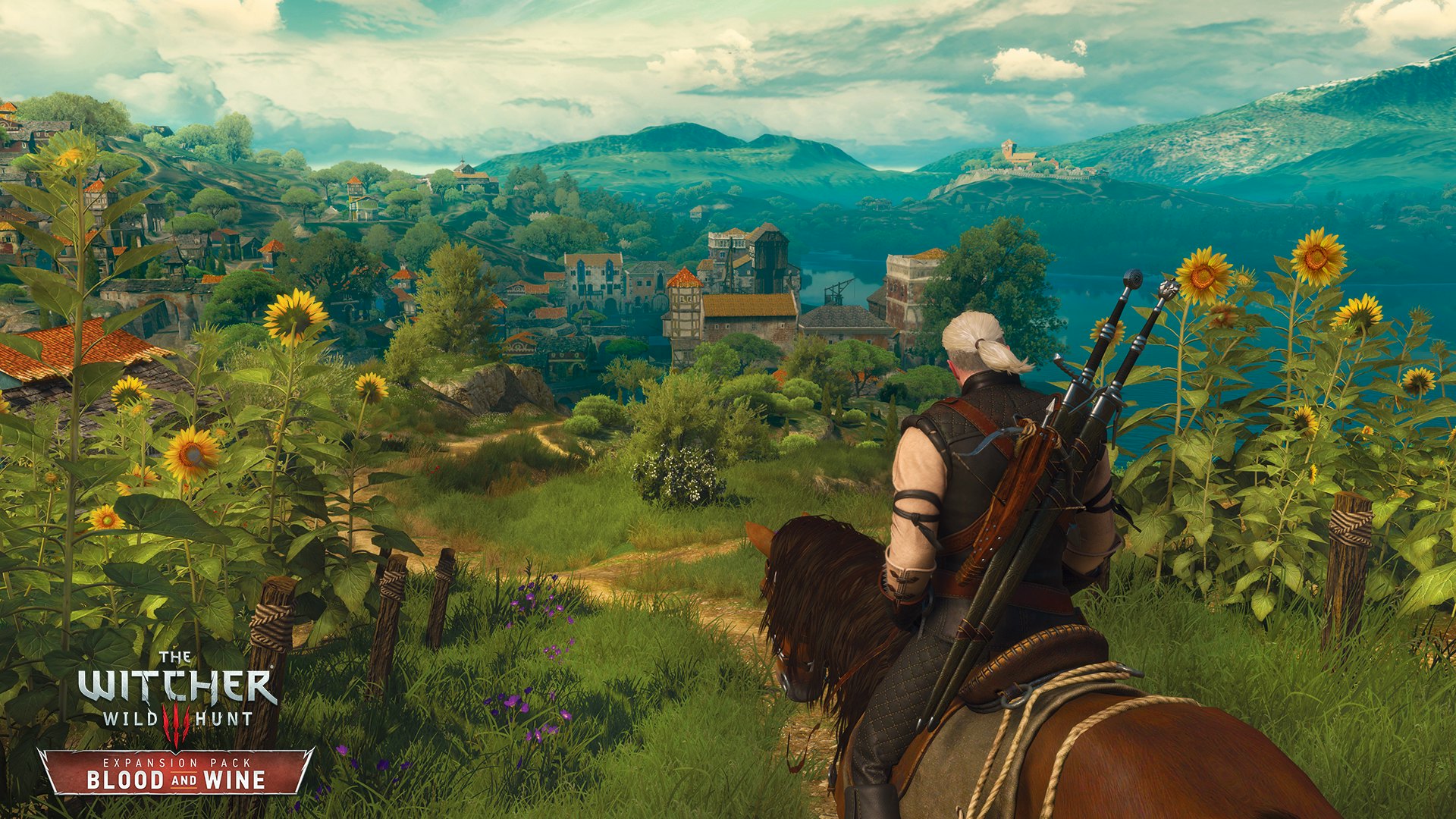 Guillaume überlässt euch somit die «Trophäe von Golyat» und sucht sich eine neue Möglichkeit das Herz seiner Angebeteten zu erobern. Ihr werdet ihn schon bald wiedersehen.
Guillaume überlässt euch somit die «Trophäe von Golyat» und sucht sich eine neue Möglichkeit das Herz seiner Angebeteten zu erobern. Ihr werdet ihn schon bald wiedersehen.
Bestiarium: Golyat [Ogroid]
Der Legende nach war Golyat einstmals ein eidbrüchiger Ritter gewesen. Die Dame vom See hatte ihn bestraft und in jenen Riesen verwandelt, als er in die Berge floh. Seitdem kam er nur einmal im Jahr noch in die Zivilisation, wenn der Hunger ihn dazu zwang. Man kann nicht wissen, was an dieser Geschichte dran ist. Fest steht, dass besagter Riese höchst gefährlich war, Schafe und Schäfer auf einmal fraß und weithin dermaßen gefürchtet war, dass die Gouvernanten die Kinder mit Geschichten über ihn erschreckten, damit sie ihr Gemüse aßen.
Golyat galt als wilde, vernunftlose Kreatur, doch er nutzte einfache Werkzeuge, und in seinen Pranken wurde jeder Gegenstand zur tödlichen Waffe. Im Kampf gegen Geralt schwang Golyat einen Mühlenstein- mit dem war jeder Streich vernichtend. Zum Glück hatte Geralt einige Erfahrung mit dem Töten von Riesen und machte kurzen Prozess mit Golyat, wobei ihm drei tapfere Ritter treulich zur Seite standen: Milton de Peyrac-Peyran, Palmerin de Launfal und Guillaume de Launfal.
Zum Glück hatte Geralt einige Erfahrung mit dem Töten von Riesen und machte kurzen Prozess mit Golyat, wobei ihm drei tapfere Ritter treulich zur Seite standen: Milton de Peyrac-Peyran, Palmerin de Launfal und Guillaume de Launfal.
Wirksam im Kampf
- Ogroidenöl
- Quen
Connect with us
- © 2006 — 2022 RPGuides.de
- Impressum / Haftungsausschluss
- Datenschutzerklärung
Blood and wine, war and love. Getting ready for the second season of The Witcher
The Witcher, one can say with certainty, is the legendary universe of the Polish writer Andrzej Sapkowski. At home, they started talking about the author immediately after the release of the first book — it was a resounding success, and Sapkowski continued to write this story, expanding the universe. Two TV series were shot based on The Witcher, fans of the series shoot fan films, videos, write fan fiction, their own offshoots from the main story, in 2009In 2008, a rock opera based on Geralt’s wanderings premiered, and, of course, three video games were released, the last of which became not only super-successful among its own kind, but also simply a work of art in this difficult industry. The saga has a simple plot. Everything takes place in a fantasy world where Geralt of Rivia, one of the last witchers, mercenaries, monster hunters, fulfills orders, getting rid of all kinds of evil spirits. Ordinary villagers, hard workers, noble citizens, even representatives of the nobility and authorities can turn to him. Geralt is an unprincipled man who sometimes seems to care only about beautiful women and good wine, so sometimes the main thing for him in the matter of work is payment: as they say, pay the witcher with a minted coin, and no middays in your fields and meadows.
The saga has a simple plot. Everything takes place in a fantasy world where Geralt of Rivia, one of the last witchers, mercenaries, monster hunters, fulfills orders, getting rid of all kinds of evil spirits. Ordinary villagers, hard workers, noble citizens, even representatives of the nobility and authorities can turn to him. Geralt is an unprincipled man who sometimes seems to care only about beautiful women and good wine, so sometimes the main thing for him in the matter of work is payment: as they say, pay the witcher with a minted coin, and no middays in your fields and meadows.
© YouTube / The Witcher Netflix
Sapkowski’s first books are collections of short stories that are not really connected by one big plot, but they immerse you in this world. From there you can learn a little about life on the continent, get to know Geralt and his life and way of life, and, of course, plunge into the universe of Slavic folklore, which the writer is happy to inspire.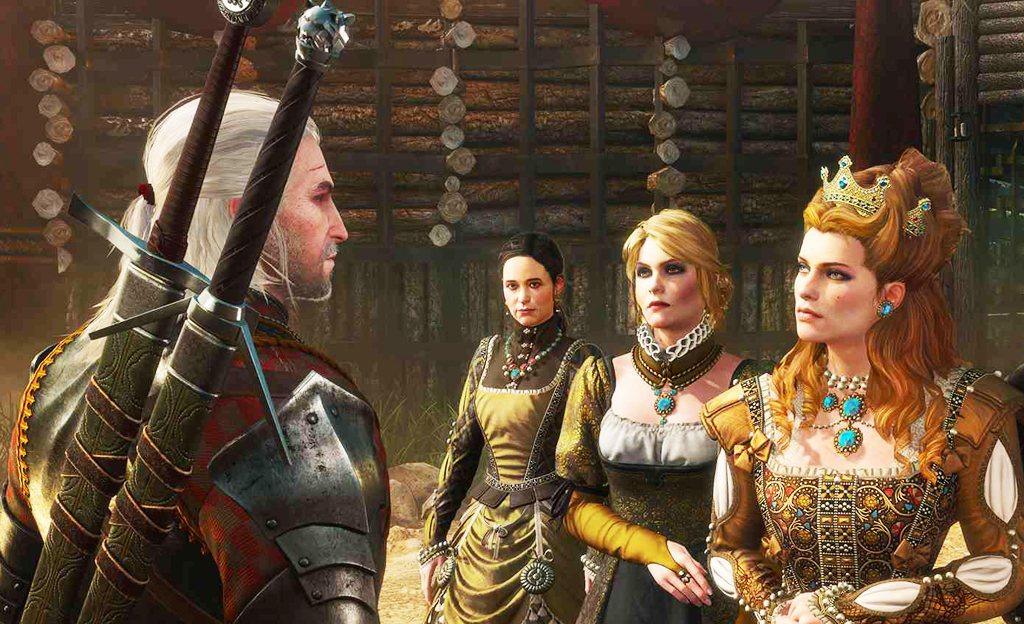 The story about his pupil Ciri, which is exactly what is unfolding in the Netflix series, appears a little later, combining subsequent books into one large-scale plot.
The story about his pupil Ciri, which is exactly what is unfolding in the Netflix series, appears a little later, combining subsequent books into one large-scale plot.
Move, Roach!
Most likely, Netflix thought about working on the series just after the success of the video game The Witcher 3: Wild Hunt, which was released in 2015. After the clear and structured world of the previous game, the creators of the Wild Hunt presented an open world — that is, it is not necessary to follow the main storyline all the time. You can stay in this universe for as long as you like. At best, you can spend about 51 hours on the passage of the «plot», if with some additional tasks — 103 hours, but on the complete passage of the game you will need as much as 173 hours of your life (which is also likely to happen with some acceleration and if you you will not stick somewhere in the middle of the location, watching the landscapes).
© YouTube / The Witcher
Despite the fact that Wild Hunt was released six years ago and during this time the game industry has not only changed, but revolutionized, this game still remains popular and insanely relevant. Judge for yourself, this world is well developed, there is a main plot related to Ciri, there are many additional missions that are not always simply related to fighting and killing monsters. There is, for example, a wonderful quest about the Bloody Baron and his dead child, there are plots connected with the help of the sorceress Yennefer, by completing which you can reveal Geralt from a completely different side he just does his job, in fact, love is not alien to him).
Judge for yourself, this world is well developed, there is a main plot related to Ciri, there are many additional missions that are not always simply related to fighting and killing monsters. There is, for example, a wonderful quest about the Bloody Baron and his dead child, there are plots connected with the help of the sorceress Yennefer, by completing which you can reveal Geralt from a completely different side he just does his job, in fact, love is not alien to him).
In addition, there are many more mechanics in the game that are interesting to understand, each of your decisions can affect the ending or development of the story, and, of course, there is a place for humor, for which everyone loves Sapkowski’s books. Why are there only quests about theatrical performances, or one of the last ones, where Geralt, along with his witcher brothers, drinks in Kaer Morhen («This is a job for Vesemir»), and quotes like «Move, Roach!» or «There’s no way you fucking will learn!» will remain in the hearts of the fans forever.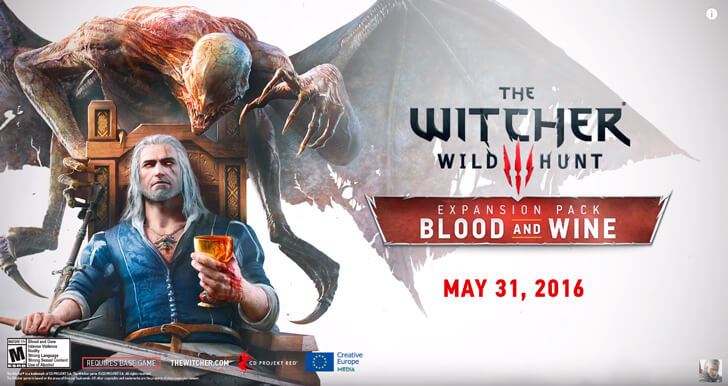 By the way, there is a lot of obscene language in games, but, as many classics said, such words should be in place, which, in fact, is here.
By the way, there is a lot of obscene language in games, but, as many classics said, such words should be in place, which, in fact, is here.
The Witcher 3: Wild Hunt premiered in Poland on May 18, 2015
© EPA/JACEK TURCZYK
So it’s no surprise that Wild Hunt became so popular and still tops the charts on many platforms today , and interest in it does not fade away. Well, after the resounding success of Game of Thrones, it is likely that such a monstrous giant of the film industry as Netflix is thinking about its own analogue. Especially considering that the worlds, atmospheres, scandals, intrigues and palace intrigues are very similar to each other.
Love lights up but casts long shadows
In 2019, when the first season of The Witcher was released starring Henry Cavill (and featuring the legendary song Toss a coin to your witcher), which, by the way, our compatriot Sonya Belousova wrote), it was clear to everyone: thanks to the promo, excellent filming, cast and noise in the fan community, the series will attract not only lovers of books and games, but also new fans. But, knowing nothing about lore, that is, about the universe of The Witcher, many of the viewers were a little shocked, and when at the end of the season the timeline (finally!) Lined up in a logical way, I wanted to stop watching in order to start it again — Well, it’s too painful for the creators to wind up this whole story with flashbacks. Moreover, witchers and sorceresses practically do not age, so it is not easy to figure out what, when and why is happening.
But, knowing nothing about lore, that is, about the universe of The Witcher, many of the viewers were a little shocked, and when at the end of the season the timeline (finally!) Lined up in a logical way, I wanted to stop watching in order to start it again — Well, it’s too painful for the creators to wind up this whole story with flashbacks. Moreover, witchers and sorceresses practically do not age, so it is not easy to figure out what, when and why is happening.
On the other hand, this is perhaps more of a plus than a minus. Judge for yourself, these time jumps are used more as a storytelling tool, and not to shock and confuse you. Moreover, when at the end, on such a great upsurge of feelings, the climax of the season, the stories of Geralt, Ciri and Yennefer finally converge into one, and the witcher finally meets his future pupil, a real catharsis occurs and we all understand: everything is intertwined and, it seems, it’s still a foregone conclusion.
A still from The Witcher TV series
© Netflix/Katalin Vermes
In the end, it turned out that the first season got very good reviews, but, as it usually happens, people who are more immersed in the history of The Witcher saw more negatives, than everyone else.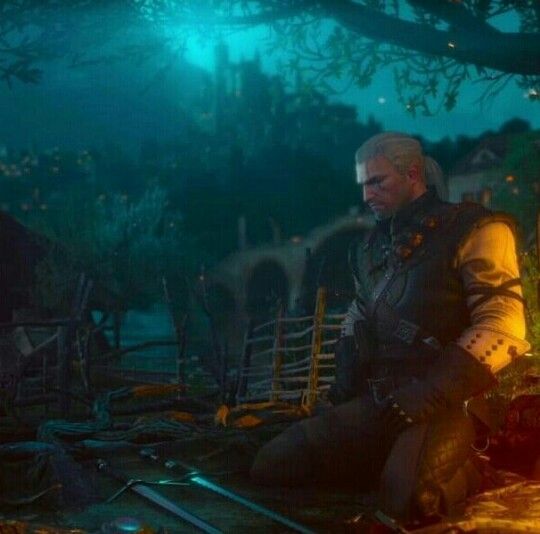 For example, there were many questions for Yennefer: for some reason, her story in the series turned out to be somewhat chaotic and even illogical. In books and games, she is a rather tough woman who can sometimes give up her feelings for the sake of cold calculation, can be a domineering, unprincipled manipulator. Netflix makes her more human.
For example, there were many questions for Yennefer: for some reason, her story in the series turned out to be somewhat chaotic and even illogical. In books and games, she is a rather tough woman who can sometimes give up her feelings for the sake of cold calculation, can be a domineering, unprincipled manipulator. Netflix makes her more human.
In addition, the same flashbacks confuse, especially when closer to the middle of the series you already stop trying to figure out what was behind what. But Henry Cavill in the role of Geralt came up perfectly. By the way, he also played games and read these books too.
Filming of The Witcher TV series
© Netflix/Katalin Vermes
But be that as it may, no matter how some tragic stories from the books are smoothed out (such as the plot about the butcher from Blaviken or about Yennefer and the genie, when Geralt meets the sorceress for the first time) and no matter what questions the fans have about the cast, after a few episodes the series starts to be madly in love. Because all projects have minuses and questions, but it is much more important what pluses there are. One of the decisive ones is shooting, scenery, locations that fascinate, costumes and monsters (which were drawn with terrifying accuracy and love for details), and, of course, the soundtrack, which, compared with the same «Game of Thrones», is nothing is not inferior, even though a team of not so famous professionals worked on it.
Because all projects have minuses and questions, but it is much more important what pluses there are. One of the decisive ones is shooting, scenery, locations that fascinate, costumes and monsters (which were drawn with terrifying accuracy and love for details), and, of course, the soundtrack, which, compared with the same «Game of Thrones», is nothing is not inferior, even though a team of not so famous professionals worked on it.
One must adhere to principles, otherwise the whole world will plunge into chaos
And there is nothing surprising in the fact that many people in the world did not understand anything after watching only the first season. In addition to the need to figure out who the witchers are and what kind of mutations boys are exposed to in childhood, why sorceresses are incorporeal, but Geralt’s mother is a sorceress, what is the right of surprise and what is Elder Blood, politics occupies a special place in the universe. The war between Nilfgaard and the kingdoms of the North (Redania, Kaedwen, Skellige and Tsintra, where everyone is also fighting among themselves) can be said to be one of the drivers of this plot, but it’s hard to understand who, where, why and why.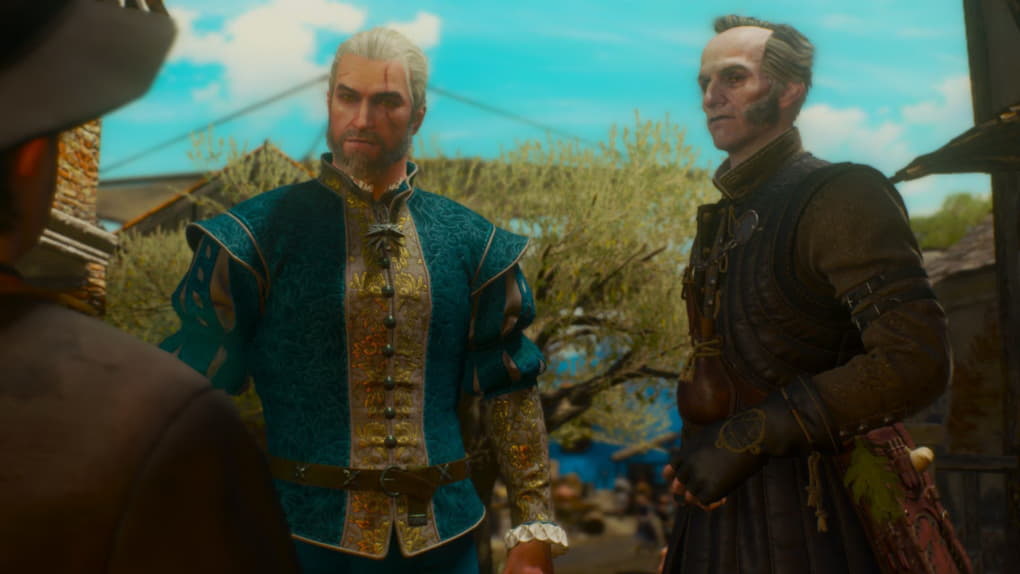 And if we start doing it here now, then most likely you will be unhappy with so many spoilers. So it remains to be hoped that everything will fall into place in the second season.
And if we start doing it here now, then most likely you will be unhappy with so many spoilers. So it remains to be hoped that everything will fall into place in the second season.
© YouTube / Netflix
Following the logic (and reading what the lucky ones who have already watched the first episodes write), the main line of the second season will be the relationship between Geralt and Ciri, who, it turns out, has no one else. They will have to get closer and become each other those close people, one family and try to build a father-daughter relationship, which in the future, for example, will involve Geralt in the slaughter with the Wild Hunt (these are the local Walkers and the King of the Night).
A shot from The Witcher series
© Netflix/Premiere Pro
And, of course, Geralt’s endless skirmishes with monsters, Ciri’s training, and let’s hope that some disclosure of the Witcher’s world awaits us.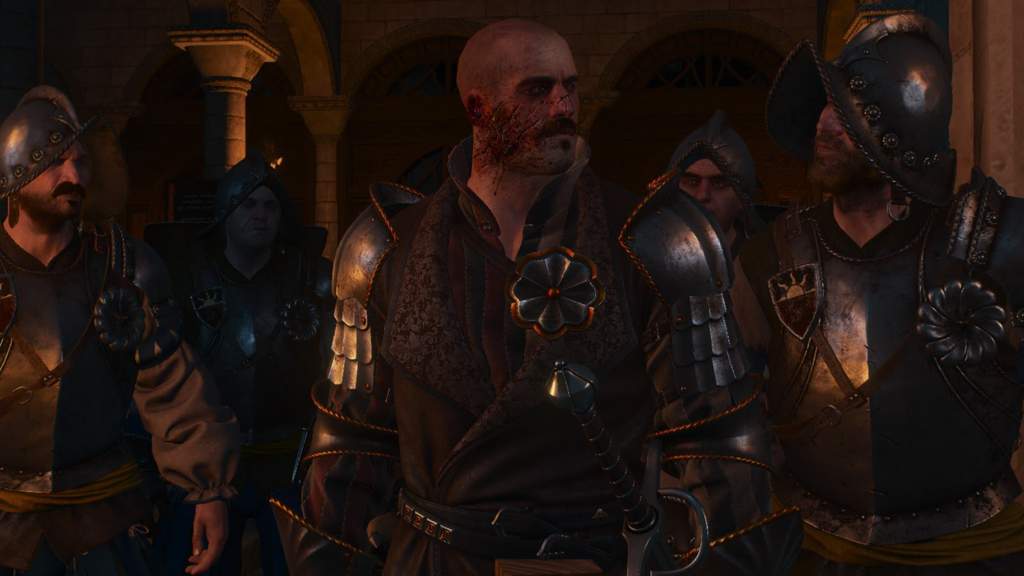 At the end of the first season, all viewers were stunned by an unexpected meeting with the mother of the protagonist — will this story develop? Whether there will be as much humor in this part as in games and books — so far we can only guess and wait for the legendary phrases of Geralt of Rivia.
At the end of the first season, all viewers were stunned by an unexpected meeting with the mother of the protagonist — will this story develop? Whether there will be as much humor in this part as in games and books — so far we can only guess and wait for the legendary phrases of Geralt of Rivia.
Cadria Sadykova
Blood and wine — the last journey — Cotonauts
In the last addition to “Witcher 3” “Blood and Wine” Geralt from Rivia is sent to the Principality of Tussent untouched by war. Princess Anna-Henrietta needs the services of a witcher to find and exterminate a certain Beast who kills knights just on the eve of a grand knightly tournament. As often happens with our hero, an ordinary order will turn into a real adventure, during which Geralt will be drawn into the maelstrom of palace intrigues and dark secrets of the seemingly carefree inhabitants of the principality.
The Toussaint location is noticeably different from the rest of the game areas. The principalities were not affected by the war and the Wild Hunt. Bright, serene, shimmering with all the colors of the rainbow, a fairy-tale kingdom, saturated with ostentatious knightly romance. The main five virtues to which the knights swear allegiance are honor, wisdom, generosity, valor and sympathy. However, as you might guess, people everywhere remain people, and even in a beautiful wrapper, unsightly human qualities remain in place.
The principalities were not affected by the war and the Wild Hunt. Bright, serene, shimmering with all the colors of the rainbow, a fairy-tale kingdom, saturated with ostentatious knightly romance. The main five virtues to which the knights swear allegiance are honor, wisdom, generosity, valor and sympathy. However, as you might guess, people everywhere remain people, and even in a beautiful wrapper, unsightly human qualities remain in place.
What the series is famous for: satire, witty dialogue and caustic humor — right here. Do not shy away from reading the notes and inscriptions on the gravestones — the screenwriters took their breath away on these hilarious sketches. Generous addition and references: to the events of «Wild Hunt» , books and popular culture in general. Blood and Wine plays the nostalgic card very cleverly. For which CD Projekt RED I want to separately hug — the studio «resurrected» one of the most charming and beloved characters by readers Sapkowski , while not with a butt on the head, but plausibly explaining such a joyful outcome of events.
«Blood and Wine» brings additional quests to a new level. Funny, sad, ambiguous, complex, different and numerous. What is worth only enchantingly funny and painfully plausible quest in the bank, where Geralt will face the most severe opponent — bureaucracy. Or a task where you will have the opportunity to participate in a real knight’s tournament and at the same time help the unfortunate knight win the heart of an impregnable beauty. In general, the Principality of Toussaint will not let you get bored. At a certain stage, Geralt will even have his own winery. It can be repaired, upgraded and decorated — there will be where to spend your hard-earned gold.
By rushing through the main story alone, the player runs the risk of missing amazing moments and charming little things that will enhance the experience a hundredfold. «Blood and Wine» is the very case when it is worth stretching out the process for the sake of the greatest pleasure. Like a glass of wine, yes.
In the second half of the main storyline, the narrative stumbles a little and breaks the rhythm. After an amazing quest, the action of which takes place in a conditional «land of fairy tales», the story does not really allow Geralt to rest, stock up, sharpen knives and recuperate, but immediately throws him into battle with the main enemy (if, of course, you decide to go this way) . By the way, a trip to the «land of fairy tales» will allow players to not only laugh a lot, but also enjoy one of the most sensual and «airy» love scenes in the series, so keep in mind.
Cosmetic changes have affected the gameplay: the creators have revised the interface, making it more convenient and functional. For example, new documents and books can be read immediately, without tedious going into the inventory. By completing a special quest, the player can open up new mutations, but, I confess, Geralt, pumped over hours of previous adventures, coped well with all opponents without them.
